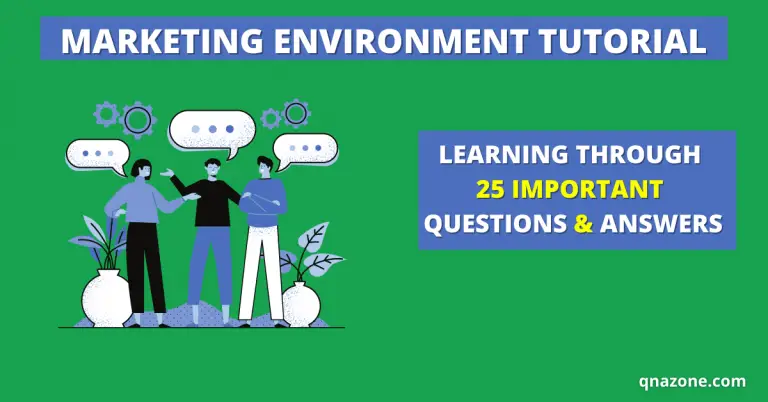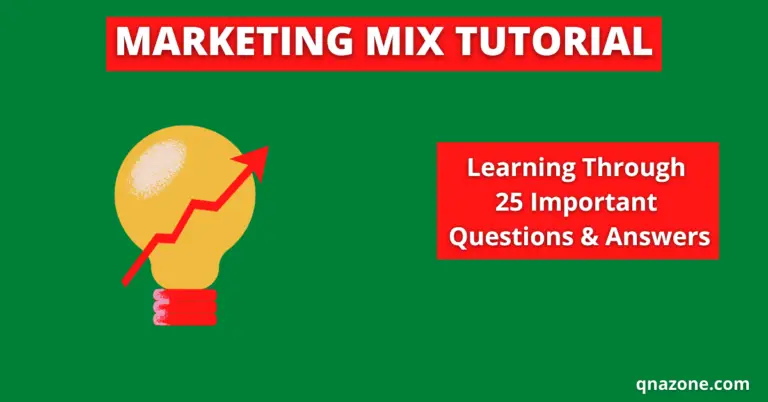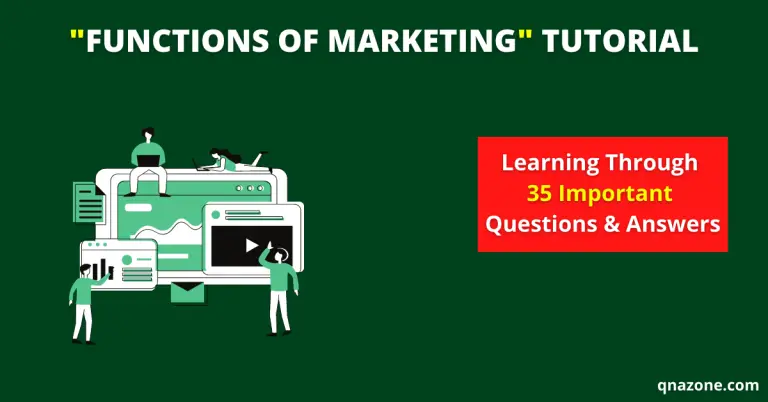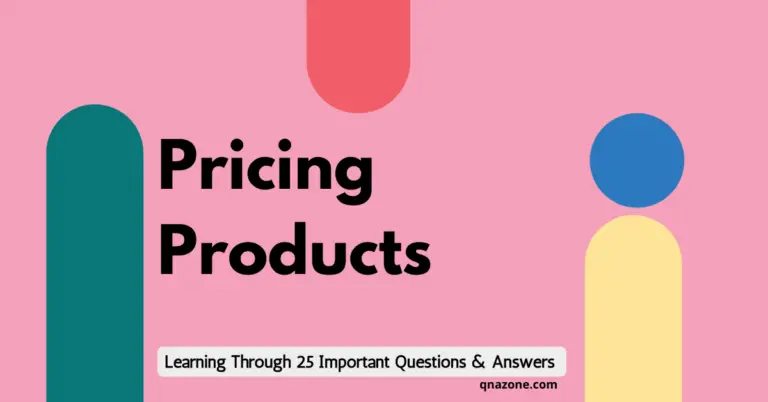35 Important Product Questions and Answers [With PDF]
The 6th chapter of our Marketing learning course is “Product”. In this article, we’ll learn the 35 most important product questions and their answers.
It will help you understand the different types of products and their explanations quickly.
By reading this post, you may quickly prepare for marketing courses and for any competitive tests such as school and college exams, vivas, job interviews, and so on.
So let’s get started…
Product Questions and Answers
The 35 important product questions and answers are as follows:
Question 01: What is a Product?
Answer: A product is anything that has perceptible visible and invisible qualities, can satisfy people’s needs, and is offered for sale to the buyer by the seller.
Question 02: What are The Features of the Product?
Answer: The important features of the product are as follows:
- Product refers to external products and services.
- Each product has a specific size.
- Occupies a place in every product.
- Products can be saved for the future.
- Products can be transferred from one person to another through buying and selling.
- Deterioration is another feature of the product
Question 03: What are The Three Levels of Product and Services?
Answer: The three levels of product and services are as follows:
- Core customer value
- Actual product
- Augmented product
Question 04: What is Core Consumer Value?
Answer: The core customer value is the inherent quality of the product that meets the basic needs of the customers. In other words, the core customer value is the service or benefit that customers expect when they buy goods.
Question 05: What is an Actual Product?
Answer: An actual product is one that is designed or structured based on the core customer value of the product.
For example, customers expect clean bedding, toilet soap and towels, water supply, laundry arrangements, sheets, and so on while staying at a hotel, which is the actual product.
Question 06: What is an Augmented Product?
Answer: All of the additional benefits that customers expect, in addition to the core customer value of the product and the actual product, is referred to as augmented products.
For example, customers expect extra facilities such as a television set, shampoo, fresh flowers, room service, internet service, delicious food, and so on when renting a hotel room.
Question 07: What are The Types of Products?
Answer: The types of products are as follows:
#1. Consumer Products
- Convenience Products
- Shopping Products
- Specialty Products
- Unsought Products
#2. Industrial Products
- Raw Materials and Parts
- Capital Items
- Supplies and Services
Question 08: What are Consumer Products?
Answer: Consumer products are products that are intended for final consumption. Consumer goods are products that are consumed or used directly by consumers after purchase, with no further processing. Such products are in a state suitable for direct consumption.
Question 09: What are the Features of Consumer Products?
Answer: The important features of consumer products are as follows:
- All the people of the world are buyers of consumer products.
- Buyers of such products usually purchase in small quantities.
- As the demand for consumer goods is very high, the amount of production is very high.
- The fashion of consumer goods is rapidly changing.
- The decision to purchase consumer goods depends on various support activities
Question 10: What are the Types of Consumer Products?
Answer: The types of consumer products are as follows:
#1. Convenience Products
- Staple products
- Impulse products
- Emergency products
- Delivery products
#2. Shopping Products
- Fashion products
- Service products
#3. Specially Products
#4. Unsought Products
- New unsought products
- Regular unsought products
Question 11: What is a Convenient Product?
Answer: A convenient product is one that can be purchased easily from a convenient location. Consumers buy such products all the time. It is not necessary to plan ahead of time to purchase such products, and buyers want to collect them as quickly as possible, i.e. with the least amount of time and energy.
Question 12: What are Staple Products?
Answer: Staple products are those products that we always require at home or on the go. For example, Rice, pulses, paper, pens, oil, soap, etc.
Question 13: What is an Impulse Product?
Answer: The product that a buyer feels compelled to buy after seeing it in a store is known as an Impulse product. For example, Magazines, toys, vases, and so on.
Question 14: What are Shopping Products?
Answer: Shopping products are those products that buyers do not normally purchase but consider the quality, price, size, design, model, and so on at the time of purchase.
Question 15: What are Fashion Products?
Answer: Fashion products are what consumers buy to adapt to changing fashions, tastes, and needs. For example, Furniture, Jewelry, New Model Mobile Phone, etc.
Question 16: What are Service Products?
Answer: Service products are shopping products that are bought for the purpose of obtaining necessary services rather than as a hobby. For example, TV, Refrigerator, Air Cooler, Washing machine, etc.
Question 17: What are Specialty Products?
Answer: Specialty products are those that have a high monetary value and are purchased by a specific group of people in society.
For example, Fashionable shoes, eye-catching watches, valuable mobile phones, and so on.
Question 18: What are Unsought Products?
Answer: Unsought products are those for which buyers have no prior knowledge or experience, or products for which buyers have never seen or felt the need to purchase. For example, a life insurance policy, an encyclopedia, and so on.
Question 19: What are Industrial Products?
Answer: Industrial products are those that are used to create new utilities rather than being used directly for final consumption.
For example, raw materials, heavy machinery, equipment, etc.
Question 20: What are The Features of Industrial Products?
Answer: The important features of industrial products are as follows:
- Buyers of industrial goods are mainly producers, so their numbers are always low.
- Such products are used in subsequent production.
- The purpose of processing or using such products is to produce consumer goods.
- The distribution system is shortened as there are fewer buyers of such products and
- Advertising or marketing promotion is less important in marketing industrial products
Question 21: What is The Difference between Consumer Products and Industrial Products?
Answer: The three important differences between consumer products and industrial products are as follows:
- The products that are used in the final consumption are consumer products, while the products that are used in the manufacturing process are industrial products.
- The number of buyers of consumer products is generally higher, while the number of buyers of industrial products is comparatively less.
- The prices of most consumer goods are generally lower, while the prices of industrial products, especially heavy machinery, equipment, parts, etc., are much higher.
Question 22: What are The Considerable Factors for Marketing Consumer Products?
Answer: The considerable factors for marketing consumer products are as follows:
- Geographical expansion
- Number of buyers
- Nature of demand
- Distribution channel
- Buying behavior
- Price
- After-sales service
Question 23: What are the Considerable Factors for Marketing Industrial or Business Products?
Answer: The considerable factors for marketing industrial or business products are as follows:
- Geographically concentrated
- Limited buyer
- Derived demand
- Nature of purchase
- Size of the market
- Distribution channel
- Security
- Market development
Question 24: What is the Product Life Cycle?
Answer: The product life cycle divides a product’s life span into several levels based on sales and profit, beginning with its introduction to the market and ending with its departure.
Question 25: What are The Steps of the Product Life-Cycle?
Answer: The steps of the product life cycle are as follows:
- Product development stage
- Introduction stage
- Growth stage
- Maturity stage
- Decline stage
Question 26: What is Product Development Stage?
Answer: The product development stage is when a company creates or develops a product based on a new product concept. At this stage, the organization creates new product ideas. Then it is developed and released to the public.
Question 27: What is Introduction Stage?
Answer: The launch stage begins as soon as the product enters the market. As a result, the introduction stage refers to the stage at which the product is first introduced to the market and made available for purchase.
Question 28: What Are The Important Features of the Introduction Stage?
Answer: The important features of the introduction stage are as follows:
- At this level, sales are very low and growing slowly.
- Extensive promotional activities must be carried out in order to establish product identity.
- A significant amount of money must be spent in the distribution sector.
- This level is risky enough.
- At this level, the majority of products do not make a profit or are very small.
Question 29: What is Growth Stage?
Answer: The growth stage refers to the period during which product sales and profits rapidly increase.
Question 30: What are the Important Features of the Growth Stage?
Answer: The important features of the growth stage are as follows:
- Product sales increase rapidly.
- Competitors enter the market as profits increase.
- Competitors add new features to the product in order to survive in the competition.
- The cost of promotion increases comparatively.
- Higher production reduces the cost per unit of the product.
Question 31: What is the Maturity Stage?
Answer: The maturity stage refers to the point in the product’s life cycle when sales reach their peak and profit begins to decline. As the product’s sales growth slows, it enters the maturation stage.
Question 32: What are the Three Types of Maturity Stages?
Answer: The three types of maturity stages are as follows:
- Growth Maturity
- Stable Maturity
- Decaying Maturity
Question 33: What are the Important Features of the Maturity Stage?
Answer: The important features of the maturity stage are as follows:
- As the number of competitors grows, so does the level of competition.
- Despite high sales, sales growth eventually stops or begins to decline.
- Product prices and profits are continuing to fall.
- Attempts to differentiate the product are made, and the product line is expanded.
- Production and distribution capacity is fully utilized in order to maintain market share.
Question 34: What is Decline Stage?
Answer: The decline stage is the point at which a product’s sales and profits begin to decline rapidly.
Question 35: What are the Important Features of The Decline Stage?
Answer: The important features of the decline stage are as follows:
- As a result of the introduction of new products into the market, demand for conventional products has decreased significantly.
- Both sales and profits are down.
- The product distribution system is small at this level.
- Many products remain unsold.
- Weak products are withdrawn from the market.
I hope that by the end of this post, you have a good understanding of the “product” chapter.
You will gain a better understanding of the “Product” chapter if you read these 35 important product questions and answers on a regular basis.
You may also read:
- 30 Important introduction to marketing questions & answers [With PDF]
- 25 Important marketing environment questions & answers [With PDF]
- 35 Important marketing functions questions & answers [With PDF]
- 25 Important marketing segmentation questions & answers [With PDF
- 25 Important marketing mix questions and answers [With PDF]
- 25 Important pricing products questions and answers [With PDF]
- 35 Important product distribution channel questions and answers [With PDF]






